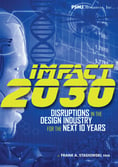 In Impact 2030, the 4th iteration of his industry-rattling book series, business management expert, author, architect, and PSMJ founder Frank Stasiowski, FAIA predicts the market, financial, technology, and demographic shifts that will upend the architecture/engineering/construction (A/E/C) businesses and explains how successful professionals will adjust.
In Impact 2030, the 4th iteration of his industry-rattling book series, business management expert, author, architect, and PSMJ founder Frank Stasiowski, FAIA predicts the market, financial, technology, and demographic shifts that will upend the architecture/engineering/construction (A/E/C) businesses and explains how successful professionals will adjust.
To be able to foresee how an entire industry and the professionals in it will thrive or perish over the next decade? "Tall order,” says Stasiowski, FAIA, “yet prognosticating the future of the design and construction industry is the single best way to prepare for, experience, and positively influence the A/E/C industry's future.”
Published by PSMJ Resources, Impact 2030: Disruptions in the Design Industry for the Next 10 Years represents the synthesis of Stasiowski’s research into how tectonic forces at work right now will demand a radical rethinking of A/E/C business models and practices by the year 2030.
IoT, quantum computing, artificial intelligence (AI), robotics, climate change, bioengineering, and increasing longevity are just a few of these forces creating new opportunities and challenges, the author claims. Assumptions that drove business strategy in the last decade will have to give way to new realities as client demands, cost constraints, population changes and more have successful designers rethinking processes.
“The of environmental resiliency in the face of climate change, for example, will emerge as a core competency for successful firms,” predicts Stasiowski. “From an engineering standpoint, expect to see buildings and their systems designed to be in full use, even during a natural disaster. And in coastal areas, designed to accommodate significantly higher sea levels.”
Drawing from data compiled by the World Economic Forum, McKinsey Global Institute, PwC, and leading academics and researchers, Impact 2030 carries trend lines already apparent to their inescapable, if often staggering, 10-year forecast so that A/E/C principals can get ahead of disruptions and take advantage of opportunities at just the right moment.
From the 10 emerging technologies that will change how buildings are constructed to the 4th industrial revolution connecting more and more systems to share data, from where design jobs will disappear forever to skills the most valuable candidates will bring, from emerging megatrends in infrastructure spending to radical new approaches to fees, compensation, and risk allocation, Stasiowski provides readers with a blueprint for both strategic and tactical planning.
 As Founder and CEO of PSMJ Resources, Inc., Frank A. Stasiowski, FAIA is a counselor, strategist, and advisor to CEOs of the top design and construction firms in the U.S. and abroad. Stasiowski is a licensed architect with degrees from the Rhode Island School of Design and an MBA from Bryant University. He has spent the last 35 years working with design firms.
As Founder and CEO of PSMJ Resources, Inc., Frank A. Stasiowski, FAIA is a counselor, strategist, and advisor to CEOs of the top design and construction firms in the U.S. and abroad. Stasiowski is a licensed architect with degrees from the Rhode Island School of Design and an MBA from Bryant University. He has spent the last 35 years working with design firms.

As clients demand that work be delivered faster, and as the workforce gets younger, and we increasingly rely on emerging technology to balance cost pressures, nowhere are specific changes discussed in terms of how they affect long term strategic decisions for A/E/C principals. IMPACT 2030 outlines how demographics, globalization, government expansion, and technology advances can benefit firms that plan ahead — and be devastating for those that don’t prepare.



